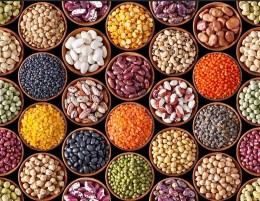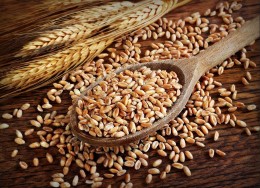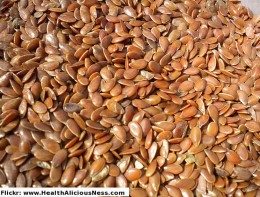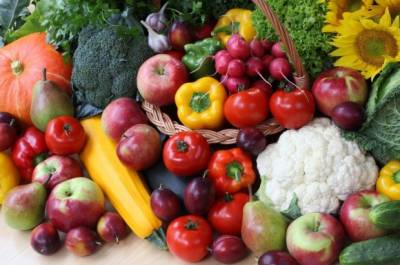DrCarney.com Blog
Fiber's Role in Preventing Breast Cancer
What is Fiber and What is its Purpose Besides "Keeping us Regular?" The word "fiber" may bring many thoughts to our minds. Helping us "stay regular" would be the most prominent thought for most of us. This is certainly true; however, fiber plays a much larger role in the prevention and reversal of disease. Its role in removing toxic waste products is an important one. Carcinogens, for example, found in meat and dairy products, are moved along more quickly when sufficient fiber is available. This is one reason why cancer rates (including breast cancer) are much lower or rare in those individuals who consume a high-fiber, whole plant food diet.
Fiber is produced and found only in whole or minimally processed plant foods. No animal-derived food contains fiber. So meat, dairy, and eggs are fiber-deficient. Fiber resists digestion in the small intestine, therefore it arrives in the large intestine still intact. The typical American diet, which is rich in heavily processed foods, oils, animal products, and sugary drinks, is a fiber-deficient diet since these products contain little or no fiber. In contrast, a whole-food, plant-based diet supplies an abundance of fiber, more than twice the recommended minimum daily intake. Most Americans consuming the standard American diet, eat a troubling 10-15 grams of fiber per day whereas a plant-based diet can easily provide 60 to 100+ grams per day. 97% of Americans are fiber deficient.
When we think of which foods contain the most fiber, whole grains and breads are thought to contain the highest amounts. Actually, all whole plant foods are rich in fiber. Surprisingly, beans come in first place. Vegetables, fruits and some nuts/seeds contain comparable amounts.
Examples of Fiber Rich Foods
Below are a few examples taken from Dr. Joel Fuhrman's article, Fiber - Especially Vegetable and Fruit Fiber - Protects Against Breast Cancer:
1 cup cooked quinoa – 5 grams fiber
1 cup cooked brown rice – 4 grams fiber
1 cup cooked kidney beans – 11 grams fiber
1 cup cooked broccoli – 6 grams fiber
1 cup blueberries – 4 grams fiber
1 tablespoon chia seeds – 6 grams fiber
- Meat = 0 fiber
- Dairy = 0 fiber
- Eggs = 0 fiber
Fiber Benefits
Citing Dr. Fuhrman's article, "Fiber takes up space in the stomach but does not provide absorbable calories, which makes meals feel more satiating and promotes weight loss. In the colon, fiber adds bulk and accelerates movement, factors that are beneficial for colon health. Soluble fiber (primarily from legumes and oats) is effective at removing cholesterol via the digestive tract, resulting in lower blood cholesterol levels. Some types of fiber are fermented by intestinal bacteria. The fermentation products, such as butyrate, have anti-cancer effects in the colon and also serve as energy sources for colonic cells. Fermentable fiber also acts as a prebiotic in the colon, promoting the growth of beneficial bacteria. Fiber intake is associated with a multitude of health benefits, including healthy blood pressure levels and reduced risk of diabetes, heart disease and some cancers."

How Fiber Protects Against Hormone-Sensitive Cancers Such as Breast Cancer
According to Dr. Fuhrman, "A recent analysis of 10 scientific studies found that higher fiber intake is associated with lower risk of breast cancer. How does fiber impact one's risk of breast cancer? Animal products, refined grains, sugars and oils contain little or no fiber. Fiber intake is a marker for greater intake of natural plant foods, many of which are known to have a variety of anti-cancer phytochemicals. Some breast cancer protective substances that have already been discovered include isothiocyanates from cruciferous vegetables, organosulfur compounds from onions and garlic, aromatase inhibitors from mushrooms, flavonoids from berries, lignans from flax, chia and sesame seeds, and inositol pentakisphosphate (an angiogenesis inhibitor) from beans. One study revealed a 52% risk reduction in breast cancer associated with a high intake of vegetable fiber, and a 46% risk reduction for fruit fiber."
Fiber Decreases Insulin Levels - Lowering Cancer Risk
"High-fiber foods help to slow emptying of the stomach and absorption of sugars, which decreases the after-meal elevation in glucose. This is meaningful because elevated glucose levels lead to elevated insulin levels, which can send pro-cancer growth signals in the body, for example via insulin-like growth factor-1 (IGF-1). As such, high dietary glycemic index and glycemic load (characteristic of refined grains and processed foods) are associated with an increase in breast cancer risk. Accordingly, a study on Korean women found that higher white rice intake was associated with higher breast cancer risk."
Fiber Reduces Circulating Estrogen Levels
"Increased exposure to estrogen is known to increase breast cancer risk. A woman may be exposed to estrogen via her ovaries' own production, estrogen production by excess fat tissue, or environmental sources such as endocrine-disrupting chemicals (like BPA). Fiber can reduce circulating estrogen levels, thereby reducing breast cancer risk, because it helps to remove excess estrogen from the body via the digestive tract. Fiber binds up estrogen in the digestive tract, accelerates its removal, and prevents it from being reabsorbed into the body. In addition, soluble fiber (as shown with prunes and flaxseed) seems to alter estrogen metabolism such that a less dangerous form of estrogen is produced, whereas insoluble fiber (wheat bran) did not have the same effect. For this reason, beans, oats, chia seeds and flaxseeds may provide some extra protection due to their high soluble fiber content."
More information on how meat/dairy raises sex hormones can be found here, here, and here. To see how a high-fiber plant-based diet removes excess sex hormones from our bodies, click here or here.
Dr. Fuhrman summarizes by saying, "Fiber itself has some breast cancer-protective properties, like limiting glycemic effects of foods and assisting in estrogen removal, but we get optimal protection when we focus on foods that are both rich in fiber and rich in phytochemicals. G-BOMBS contain numerous anti-cancer phytochemicals, and greens, mushrooms, and flax and chia seeds in particular contain anti-estrogenic substances in addition to fiber, making them more effective breast cancer fighters than whole grains."
For more information, click on the following links:
(1) Fiber's Many Unknown Benefits
(2) Healthy Food = Healthy Colon
(3) 97% of People Are Deficient in This Nutrient
(4) Using Diet to Prevent Colon Polyps
(5) Reducing Menopause Symptoms
(7) Phytic Acid in Grains? No Problem!
(8) Dr. Carney's Cancer Pinterest Board
(9) Dr. Carney's Men's Health (Prostate Cancer) Pinterest Board
Joel Fuhrman MD Links
Scroll Down Page to Leave Comments

Starch-Smart Social Networking
Join our Online Support Community at DrCarney.com/community featuring Starch-Smart Discussions, Blogs and more by signing up for a free membership to Dr. Carney's Community.
When you subscribe to the blog, we will send you an e-mail when there are new updates on the site so you wouldn't miss them.




